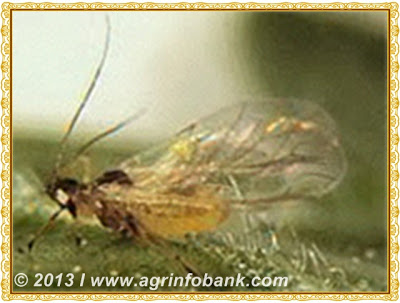Agriculture

- Damage And Biological Management Of Aphids In Mustard
Aphid: Lipaphis erysimi DAMAGE Aphid is one of the most damaging insect pest and this pest mat reduce the yield 50 to 80%. Both adults and nymphs are harmful. They suck cell sap from all plant parts. Week plant, curled leaves, hindering of flowers and...
- Top Ten Garden Insect Pests
The following list of pest descriptions and control measures provides a good starting point for tackling pest control in gardens throughout the United States and Canada. Control solutions are listed in order of environmental friendliness. Botanical sprays,...
- Aphids Biology And Control
Quick Facts...Aphids are found on almost all types of plants and a few species can cause plant injury. Some aphid species can curl the new leaves of some types of plant.Feeding aphids excrete honeydew, a sticky fluid that can cause nuisance ...
- Aphids--organic Control
Aphids are soft, pear-shaped, and very tiny (1/16 to 3/8 inch long). Two short tubes project backward from the tip of their abdomen. Aphids have long antennae. Some types of aphids have wings, which are transparent, longer than their body, and held like...
- 7 Insects You Actually Want In Your Garden
1. Lady Beetles Benefits Of Having Them In Your Garden: They eat aphids and other softbodied pest eggs, scales and whitefly nymphs. Bait Them With: Asters, marigolds, cosmos, cilantro, yarrow, dill, cabbages, sweet alyssum, flowering kale. ...
Agriculture
How to Get Rid of Aphids
By Colleen Vanderlinden

Insect Name:
Aphids, also known as plant lice.
Description:
Aphids are roughly 1/10th of an inch long. The most common colors are green and black, though brown, reddish-brown, and gray aphids inhabit some parts of the country. They have two long, tubular appendages on the tail end of their body.
Life Cycle:
Aphid eggs overwinter attached to plants, then hatch as nymphs in the spring. These nymphs produce eggs asexually, and produce more nymphs, who grow to maturity in one week. In the fall, nymphs will lay eggs that contain some male aphids, who will mate with the nymphs to produce the eggs that will overwinter and start the next generation of aphids. Mature aphids lay three to six eggs per day.
Signs of Aphid Infestation:
Aphids suck the sap out of tender plant shoots and leaves. They suck the sap in through their beak-like mouths, while injecting leaves with their saliva. Drinking the sap can weaken the plant, and injecting their saliva can spread diseases from plant to plant. In addition, aphids excrete a sticky, clear substance called "honey dew" which commonly develops sooty mold. Sooty mold is unsightly and interferes with the plant's ability to photosynthesize.
Effect on Garden Plants:
Aphids can weaken a plant, stunt its growth, cause leaves to curl or wilt, and delay fruit or flower production.
Organic Controls for Aphids:
Sometimes, a strong blast of water from the hose will knock the aphids off of a plant and solve the problem. If you attract or purchase certain beneficials, such as lady bugs, lacewings, parasitic wasps, or damsel bugs, they will attack the aphids. Plants can also be sprayed with insecticidal soap, or a homemade tomato leaf or garlic spray to kill and repel aphids.
Source of Article: http://organicgardening.about.com/
- Damage And Biological Management Of Aphids In Mustard
Aphid: Lipaphis erysimi DAMAGE Aphid is one of the most damaging insect pest and this pest mat reduce the yield 50 to 80%. Both adults and nymphs are harmful. They suck cell sap from all plant parts. Week plant, curled leaves, hindering of flowers and...
- Top Ten Garden Insect Pests
The following list of pest descriptions and control measures provides a good starting point for tackling pest control in gardens throughout the United States and Canada. Control solutions are listed in order of environmental friendliness. Botanical sprays,...
- Aphids Biology And Control
Quick Facts...Aphids are found on almost all types of plants and a few species can cause plant injury. Some aphid species can curl the new leaves of some types of plant.Feeding aphids excrete honeydew, a sticky fluid that can cause nuisance ...
- Aphids--organic Control
Aphids are soft, pear-shaped, and very tiny (1/16 to 3/8 inch long). Two short tubes project backward from the tip of their abdomen. Aphids have long antennae. Some types of aphids have wings, which are transparent, longer than their body, and held like...
- 7 Insects You Actually Want In Your Garden
1. Lady Beetles Benefits Of Having Them In Your Garden: They eat aphids and other softbodied pest eggs, scales and whitefly nymphs. Bait Them With: Asters, marigolds, cosmos, cilantro, yarrow, dill, cabbages, sweet alyssum, flowering kale. ...
